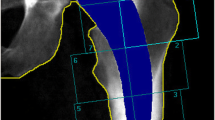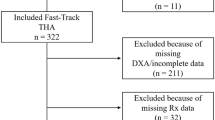Abstract
Purpose
Bone loss around uncemented femoral components is suspected to precede implant loosening and contribute to problems in revision surgery. Short-stemmed cementless femoral components are designed to preserve proximal femoral bone stock and ultimately the longevity of the prosthesis.
Methods
With quantitative computed tomography-assisted osteodensitometry, we prospectively analyzed femoral cortical and cancellous bone density (BD) and contact area changes of an uncemented collum femoris preserving stem (n = 38) 10 days, 1, 3 and 7 years post-operatively.
Results
Seven years post-operatively, cancellous BD (mg CaHA/mL) had decreased by as much as −66 % and cortical BD by up to −27 % at the metaphyseal portion of the femur; the decrease was progressive between the 1- and 3-year examinations and halted thereafter. Contact area (in % out of a possible 100 %) decreased proximally between the 1- and 3-year follow-up.
Conclusion
Proximal cortical and cancellous bone density loss and decrease of contact area indicate that metaphyseal fixation cannot be achieved. The lack of cortical BD loss and increase of contact area values below the trochanter minor suggest diaphyseal fixation.


Similar content being viewed by others
References
Albanese CV, Santori FS, Pavan L, Learmonth ID, Passariello R (2009) Periprosthetic DXA after total hip arthroplasty with short vs. ultra-short custom-made femoral stems: 37 patients followed for 3 years. Acta Orthop 80(3):291–297
Behrens BA, Nolte I, Wefstaedt P, Stukenborg-Colsman C, Bouguecha A (2009) Numerical investigations on the strain-adaptive bone remodelling in the periprosthetic femur: influence of the boundary conditions. Biomed Eng Online 8:7
Chen HH, Morrey BF, An KN, Luo ZP (2009) Bone remodeling characteristics of a short-stemmed total hip replacement. J Arthroplast 24(6):945–950
Dorr LD, Faugere MC, Mackel AM, Gruen TA, Bognar B, Malluche HH (1993) Structural and cellular assessment of bone quality of proximal femur. Bone 14(3):231–242
Espehaug B, Havelin LI, Engesaeter LB, Langeland N, Vollset SE (1997) Patient-related risk factors for early revision of total hip replacements. A population register-based case-control study of 674 revised hips. Acta Orthop Scand 68(3):207–215
Freeman MA, Plante-Bordeneuve P (1994) Early migration and late aseptic failure of proximal femoral prostheses. J Bone Joint Surg Br 76(3):432–438
Furnes O, Lie SA, Espehaug B, Vollset SE, Engesaeter LB, Havelin LI (2001) Hip disease and the prognosis of total hip replacements. A review of 53,698 primary total hip replacements reported to the Norwegian Arthroplasty Register 1987-99. J Bone Joint Surg Br 83(4):579–586
Houde J, Marchetti M, Duquette J et al (1995) Correlation of bone mineral density and femoral neck hardness in bovine and human samples. Calcif Tissue Int 57(3):201–205
Huiskes R, Weinans H, Dalstra M (1989) Adaptive bone remodeling and biomechanical design considerations for noncemented total hip arthroplasty. Orthopedics 12(9):1255–1267
Johnston RC, Fitzgerald RH Jr, Harris WH, Poss R, Muller ME, Sledge CB (1990) Clinical and radiographic evaluation of total hip replacement. A standard system of terminology for reporting results. J Bone Joint Surg Am 72(2):161–168
Jonkers I, Sauwen N, Lenaerts G, Mulier M, Van der Perre G, Jaecques S (2008) Relation between subject-specific hip joint loading, stress distribution in the proximal femur and bone mineral density changes after total hip replacement. J Biomech 41(16):3405–3413
Kerner J, Huiskes R, van Lenthe GH et al (1999) Correlation between pre-operative periprosthetic bone density and post-operative bone loss in THA can be explained by strain-adaptive remodelling. J Biomech 32(7):695–703
Kobayashi S, Saito N, Horiuchi H, Iorio R, Takaoka K (2000) Poor bone quality or hip structure as risk factors affecting survival of total-hip arthroplasty. Lancet 355(9214):1499–1504
Mazess RB (1982) On aging bone loss. Clin Orthop Relat Res (165):239–252
Mjoberg B, Selvik G, Hansson LI, Rosenqvist R, Onnerfalt R (1986) Mechanical loosening of total hip prostheses. A radiographic and roentgen stereophotogrammetric study. J Bone Joint Surg Br 68(5):770–774
Morrey BF, Adams RA, Kessler M (2000) A conservative femoral replacement for total hip arthroplasty. A prospective study. J Bone Joint Surg Br 82(7):952–958
Mueller LA, Nowak TE, Haeberle L et al (2010) Progressive femoral cortical and cancellous bone density loss after uncemented tapered-design stem fixation. Acta Orthop 81(2):171–177
Muller LA, Wenger N, Schramm M, Hohmann D, Forst R, Carl HD (2010) Seventeen-year survival of the cementless CLS Spotorno stem. Arch Orthop Trauma Surg 130(2):269–275
Nishii T, Sugano N, Masuhara K, Shibuya T, Ochi T, Tamura S (1997) Longitudinal evaluation of time related bone remodeling after cementless total hip arthroplasty. Clin Orthop Relat Res (339):121–131
Nowak M, Nowak TE, Schmidt R, Forst R, Kress AM, Mueller LA (2011) Prospective study of a cementless total hip arthroplasty with a collum femoris preserving stem and a trabeculae oriented pressfit cup: minimum 6-year follow-up. Arch Orthop Trauma Surg 131(4):549–555
Pipino F, Keller A (2006) Tissue-sparing surgery: 25 years’ experience with femoral neck preserving hip arthroplasty. J Orthop Traumatol 7:36–41
Rosenthall L, Bobyn JD, Brooks CE (1999) Temporal changes of periprosthetic bone density in patients with a modular noncemented femoral prosthesis. J Arthroplasty 14(1):71–76
Santavirta S, Konttinen YT, Bergroth V, Eskola A, Tallroth K, Lindholm TS (1990) Aggressive granulomatous lesions associated with hip arthroplasty. Immunopathological studies. J Bone Joint Surg Am 72(2):252–258
Schimmel JW, Huiskes R (1988) Primary fit of the Lord cementless total hip. A geometric study in cadavers. Acta Orthop Scand 59(6):638–642
Schramm M, Keck F, Hohmann D, Pitto RP (2000) Total hip arthroplasty using an uncemented femoral component with taper design: outcome at 10-year follow-up. Arch Orthop Trauma Surg 120(7–8):407–412
Taylor M, Tanner KE (1997) Fatigue failure of cancellous bone: a possible cause of implant migration and loosening. J Bone Joint Surg Br 79(2):181–182
Taylor M, Tanner KE, Freeman MA, Yettram AL (1995) Cancellous bone stresses surrounding the femoral component of a hip prosthesis: an elastic-plastic finite element analysis. Med Eng Phys 17(7):544–550
Taylor M, Tanner KE, Freeman MA, Yettram AL (1995) Finite element modelling—predictor of implant survival? J Mater Sci 6:808–812
Turner AW, Gillies RM, Sekel R, Morris P, Bruce W, Walsh WR (2005) Computational bone remodelling simulations and comparisons with DEXA results. J Orthop Res 23(4):705–712
Venesmaa PK, Kroger HP, Miettinen HJ, Jurvelin JS, Suomalainen OT, Alhava EM (2001) Monitoring of periprosthetic BMD after uncemented total hip arthroplasty with dual-energy X-ray absorptiometry—a 3-year follow-up study. J Bone Miner Res 16(6):1056–1061
Wolff J (1892) Das Gesetz der Transformation der Knochen. Verlag von August Hirschwald, Berlin
Acknowledgments
The study was sponsored by Waldemar LINK GmbH & Co. KG, Hamburg, Germany.
Conflict of interest
The authors declare that they have no conflict of interest.
Author information
Authors and Affiliations
Corresponding author
Additional information
A. M. Kress and R. Schmidt contributed equally to this paper.
Rights and permissions
About this article
Cite this article
Kress, A.M., Schmidt, R., Nowak, T.E. et al. Stress-related femoral cortical and cancellous bone density loss after collum femoris preserving uncemented total hip arthroplasty: a prospective 7-year follow-up with quantitative computed tomography. Arch Orthop Trauma Surg 132, 1111–1119 (2012). https://doi.org/10.1007/s00402-012-1537-0
Received:
Published:
Issue Date:
DOI: https://doi.org/10.1007/s00402-012-1537-0




